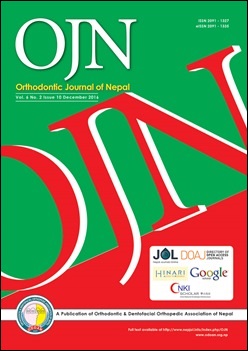Evaluation of the Effect of Complete and Partial Osseointegration in Stress Development at Bone-Implant Interface: A 3D Finite Element Study
DOI:
https://doi.org/10.3126/ojn.v6i2.17416Keywords:
cancellous bone, cortical bone, Finite element analysis, mini-implant, Von Mises stressAbstract
Introduction: Mini-implant has been in use as temporary anchorage device in orthodontics. Various factors like length, type of osseointegration, magnitude and direction of force, insertion angle of the mini-implant affect the stress development at the bone and implant interface. Development of undesirable stress at the bone-implant interface can lead to bone defect and failure of the implant. Various opinions regarding the need of osseointegration have been reported.
Objective: To study the effect of complete and partial osseointegration on Von Mises stress distribution at the bone-implant interface.
Materials & Method: Finite element model of 9mm × 1.5mm mini-implant and bone segment of 1.5mm were constructed to simulate the biomechanical response of the bone to the mini- implant by using CATIA V5-6R 2013 software. Stress developed on implant and bone were analyzed by using ANSYS: 13 2013 version software for both complete and partial level of osseointegration.
Result: Maximum Von Mises stress in complete osseointegration was 14.49 Mpa in cortical bone, 0.551 Mpa in cancellous bone and 50.76 Mpa in implant. In partial osseointegration, it was 18.68 Mpa in cortical bone, 1.23 Mpa in cancellous bone and 66.80 Mpa in mini-implant.
Conclusion: In partial osseointegration, stress developed was higher but well below the yield strength of respected continuum. So the partial osseointegration is a good compromise between the necessity of reducing mobility of implant and the necessity for easier screw removal. Key words: cancellous bone, cortical bone, Finite element analysis, mini-implant, Von Mises stress
Downloads
Downloads
Published
How to Cite
Issue
Section
License
Copyright © held by Orthodontic & Dentofacial Orthopedic Association of Nepal
- Copyright on any research article is transferred in full to the Orthodontic & Dentofacial Orthopedic Association of Nepal upon publication in the journal. The copyright transfer includes the right to reproduce and distribute the article in any form of reproduction (printing, electronic media or any other form).
- Articles in the Orthodontic Journal of Nepal are Open Access articles published under the Creative Commons CC BY License (https://creativecommons.org/licenses/by/4.0/)
- This license permits use, distribution and reproduction in any medium, provided the original work is properly cited.




